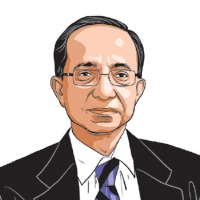In Good Faith: A journey, an education
Travelling in rural Bengal, Jharkhand I saw a village school at the cutting edge, and met ordinary people distressed by political cults of a hate-filled Hinduism.

(Representational purpose)
From the terrace of the small guest house, with the dawn struggling to break through the mists of a monsoon night, the landscape is desolate. A light wind blows over the vast, largely-uninhabited landscape, creating a hush of rustled leaves. Far away, a lake gives off a faint, early-morning shimmer. Peering into this landscape, at once mystical and mysterious, one could visualise the moors of Yorkshire at the time of the Bronte sisters. Standing alone on the terrace, gradually seeing the green of the palash trees, the red and blue of the swings in the school yard, and the distant hills of Purulia, where Bengal abuts Jharkhand, my mind fills with hope.
This was the end of a three-day visit, which began on July 28, when I landed at Ranchi and drove for four hours through Jharkhand and the western fringe of Bengal. I was there to see a village school and an eye hospital run by the NGO, Nanritam. Nanritam was founded in 2002, in memory of Swami Lokeswarananda of the Ramakrishna Mission, by two women. It started work in the Para Block of Purulia District in 2004, with a team of dedicated doctors and social workers, many of whom travel there regularly from Kolkata and the nearby town of Purulia. The original aim was to run an eye hospital and agricultural extension work for poor farmers. That work is still flourishing. The eye hospital with its modern surgical equipment, clean rooms and corridors, and a steady turnover of poor patients, many staying overnight for surgery, could well be a facility in a modern city.
But, given my own interest in education, I spent a disproportionate amount of time at the school set up in 2014 next to the eye hospital — the Filix School. It turns out to be an unexpected experience. The school already has over 400 students and classes run from nursery to grade 6. Most students pay a regular tuition fee but a large number — for this is a poor region — pay nothing. But all wear the same uniform and sit together, learning, laughing and playing, unaware of their diverse wealth, religion and caste backgrounds.
Living in New York, I had for some time been wanting to see how a 3-D printer actually works. Little did I know that my first experience of 3-D printing would occur in Filix School, with a group of wide-eyed sixth-graders jostling to show me how it works. What is rare about the school is the quality of modern education that is being imparted. They learn about their heritage and history, but, importantly from the point of view of career, they learn to speak English, are taught logic, mathematics and modern science. Some of the techniques of education used here are from Finland, which has been a leader in school education, and a country that the founders of Nanritam visited with the explicit idea of bringing the best ideas to India.
Both teachers and students seem to enjoy school. As I go from class to class, the students shower me with logic and IQ questions. Some of these are tough enough that I have no idea what the answers are, and so am forced to employ the only strategy for such situations: I pretend that I am pretending that I do not know the answers.
The model of Filix School deserves to be taken to other parts of India. The modernity of this school is exemplary and it is encouraging to see how well the children of these remote areas are embracing it. With the arrival of artificial intelligence and robotics, this kind of education will be critical. It is important for India that we spend time doing science and mathematics, instead of trying to show that we did science and mathematics five thousand years ago.
After the school visit, I take advantage of being in this tribal terrain, where, till a few years ago, it would be impossible to move around because of the risk of Maoist attacks, to visit little villages with evocative names like Chorida and Tamna, and travel through the hills of Ajodhya, an extension of the Chota Nagpur plateau.
The Santals, who inhabit these villages and forests, constitute one of the largest tribes of India. Dark-skinned and beautiful, they settled in the Indian Subcontinent way before the arrival of the Aryans. Their villages, lined with artisan homes, with hand-painted facades, are a visual treat. Their language belongs to the Austroasiatic group that is used by nearly 120 million people, spread over South Asia, the Khmer region and southern China. It originally had no script of its own. Raghunath Munda, an innovative Santal leader, developed a script in the early 20th century, called Ol Chiki, which has now caught on widely.
In the village of Hathimara, in Huda Block, a talented young artist tells us about their art and festivals. The big one is Kali puja, though unlike in traditional Hinduism, they do not have any idols to go with the festival. Talking to these people, it is impossible not to marvel at our own history and wonder where we come from, who our ancestors are and the connections that all human beings have across vast geographic spaces and continents.
The final morning, I wake up early, to see the dawn break and attend the morning prayer, mangal arati, at 5 am, at the chapel of Ramakrishna. The chiming of the bells and the chanting of the Sanskrit verses adds to the sense of wonder.
I do not want to mislead my reader. I am a sceptic, with very few beliefs, beyond logical truths. I believe that anything that is not logically impossible is possible. What fascinates me about the mangal arati is not religion but its aura of philosophy. It is a reminder of how little we know and the need for humility. It captures a spirit of Hinduism so different from the cults of hatred being abetted by political groups. Travelling through these villages, talking to ordinary folks, I am heartened to see them distressed too by these cults. And that is what gives me the hope I mentioned at the start.
The writer is C Marks Professor at Cornell University and former chief economist and Senior Vice President, World Bank
For all the latest Opinion News, download Indian Express App
More From Kaushik Basu
- Economic Graffiti: A Hinduism more tolerantAt the Ramakrishna Mission complex in Kolkata, a different face of the religion is visible from what is propagated by Hindutva..
- Economic Graffiti: The angry intellectualOne of the finest minds of our times, Ashok Mitra was anguished by poverty and inequality. His anger sometimes led him to make mistakes...
- Economic Graffiti: Why morality matters to economicsTo deal with corruption, it is not enough to just get fiscal policies right. It is in our collective long-term interest to nurture individual values...







































No hay comentarios:
Publicar un comentario